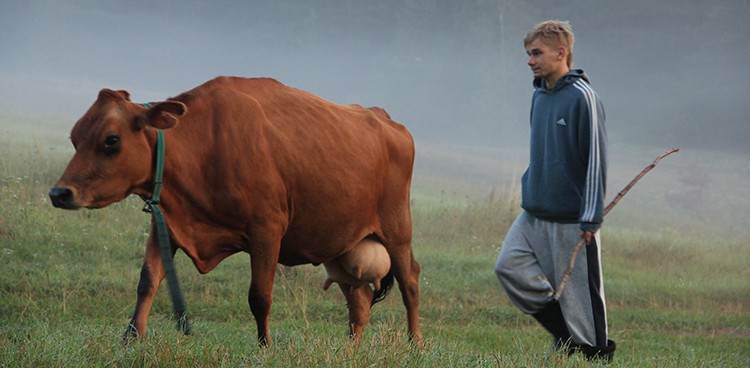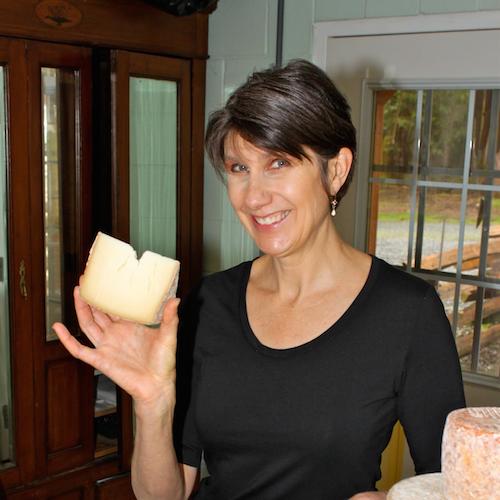
It’s emotionally jarring to stroll through a seemingly pristine, lush forest and come upon an odd depression in the earth: a berm of fern-adorned soil encircling a sunken hole carpeted with moss, which is actually a bomb crater from World War II. But this striking visual contrast—hope blooming in a former battleground—is a reminder of Lithuania’s resilience. The same perseverance can be seen in the nation’s fiercely independent people, many of whom are embracing their freedom by making sūriai (cheese).
Some Americans might be hard-pressed to locate this small European country on a map. (For the record, it’s at the same latitude as northern Scotland and the Gulf of Alaska.) I myself didn’t know that Latvia, Estonia, and Lithuania make up the Baltic states until last August, when I was invited to judge the region’s inaugural cheese competition and visit members of the Lithuania Cheesemakers Association. Such ignorance is not altogether surprising. While its inhabitants have been known as Lithuanians for centuries, Lithuania has long struggled to retain its national identity amid war and political strife.
Though by mutual agreement, the union between Lithuania and Poland in the mid-1500s—to avoid annexation by Russia—is considered by most modern Lithuanians as the first in a series of foreign, culture-extinguishing occupations. Over the centuries, Russia, Poland, and Germany variously claimed the area and redrew borders. It wasn’t until 1990 that Lithuania declared independence from the crumbling Soviet Union, setting the stage for the future of artisan cheese in the country. Laima Stankeviča, a gregarious, enthusiastic woman from Latvia (just across Lithuania’s northern border), sums up her inspiration for making cheese: “I went to the supermarket [after independence] and suddenly there was so much cheese, I was in shock,” says Stankeviča, who won a first place award in last year’s competition. “I made my mother buy some. I tasted it, and fell in love with cheese.”
Moving Forward
Before 2009, there were very few artisan cheesemakers in Lithuania. That year, however, a collapse in milk prices throughout Europe threatened the survival of small farmers. To keep dairy farms in business and to prevent people from migrating from rural villages to cities and other European Union countries, the Lithuanian government passed new rules that allowed small dairies to create farmstead cheese operations. They are limited to processing no more than 1,000 liters (about 260 gallons) of milk per day and may only sell products directly to consumers. Today the Lithuania Cheesemakers Association boasts nearly 30 members (all but one are small producers—the outlier exceeds the aforementioned volumes and must adhere to stricter rules). Similar to many US creameries, one or more of the owners of each small farmstead work off the farm in another profession. Still, such endeavors enhance their lives and help Lithuania retain its agrarian roots.
“When people have been forced to cooperate by their government, they are naturally suspicious and reluctant,” says the association’s founder Audrius Jokubauskas, a cheesemaker, shepherd, and my host for the trip. “Yet coming together to collaborate and create new opportunities is an expression of independence and freedom.” For cheesemakers, most of these new opportunities exist at the direct sales level.
Indeed, farmers’ markets are bustling with vendors from Lithuania and surrounding countries hawking poultry, produce, pots, cheese, and other wares. On any given day one might find smoked string cheese from Russia displayed in a cardboard box; fresh and aged wheels set on simple tables without fanfare; and the country’s only traditional cheese, Lithuanian white cheese. Akin to Indian paneer and Mexican queso fresco, it was traditionally made by leaving warm cow’s milk from the evening milking to sit and sour until the next day, when it was combined with morning milk and heated, causing proteins to coagulate and form curds. At the markets, it’s sold fresh or baked golden brown—crusty and blistered, the cheese resembles a loaf of bread.
In the same spirit of cooperation championed by Jokubauskas, new collaborative marketplaces are springing up around the nation. Foremost in this example is Mano Guru, an eatery in the stately capital of Vilnius. The café’s mission is to serve food and to serve the people—not only do the owners hire recovering addicts to wait on patrons, they also host a gourmet market in the space on Sundays. Nearly every cheesemaker in the region, area bakers, and purveyors of quail eggs, chanterelles, cider, and other delicacies sell to almost 500 eager customers (mostly locals with a handful of tourists). Jokubauskas proudly points to this weekly event as a model that can be exported across Eastern Europe to support farmers and makers.
Cheese in All Corners
Everywhere I travel in the nation, I notice dismal remnants of Soviet conquest, from defaced, gutted Catholic cathedrals seized and turned into armories to gloomy, monochromatic housing units where workers had been forced to live under occupation. But encouragingly, I also encounter locals who are reclaiming these resources and repurposing them for their needs. In Molėtai, a town north of Vilnius, Birutė and Giedrius Prakapavičiai have fashioned several rambling structures—once a massive Soviet mechanics garage—into an organic dairy and the country’s largest farmstead cheese operation. Along with family members, the couple turns milk from 180 Lacaune sheep and 80 Saanen goats into aged cheeses, including the robust, nutty mixed-milk Ūta, which took Best in Show at the competition I judged. Although it runs a relatively large enterprise compared to other producers, the couple sells all of its cheese at the farm’s store and one farmers’ market.
On the opposite side of the country, not far from the shores of the Baltic Sea, are the lake-studded Žemaitija National Park and the picturesque farm of cheesemakers Giedrė and Paulius Klapatauskai. The pair, who hold various degrees in history, law, and psychology, left Vilnius to reside in the park in a partly restored 120-year-old farmhouse, where they raise their children, milk cows, and enjoy the cathartic pleasure of a smoky, humid pirtis (sauna).
“I still do not fully understand why I chose to live in Vilkai [their village]—I just like this place with its old history and spirit,” Giedrė explains, as we taste cheeses from his cellar paired with Lithuanian beer. Adds Paulius: “Raw-milk cheese is not typical in Lithuania. We were drawn to its creativity and the hard work.”
Their quaint, red house holds its own secrets from the past and further evidence of the indomitable Lithuanian spirit. Hidden in a cupboard behind a hanging tapestry is a secret compartment. When the house was still young and the country under Russian rule, books written in the outlawed native language took refuge in the nook.
Robertas Grigas, a home cheesemaker and brewer who learned to make beer while living in the United States, transports me to a century-old farmhouse, with doorways so low they meet my forehead on more than one occasion. There, near the border of Belarus, father-son team Giedrius and Lukas Tėvelis milk 15 cows—Jerseys crossed with the sturdy Lithuanian brown cow—in an old, hand-hewn log barn. Milk is cooled with spring water and driven to Sūrinė Varinis Puodas, or Copper Kettle Dairy. Located in Dzūkija National Park, the tiny, efficient creamery is co-owned by Giedrius Tėvelis and Jokubauskas, my host. Together they transform milk from East Friesian sheep and cows into delightful fresh cheeses and complex aged varieties. In fact, their Briujeras, a cow’s milk cheese aged eight months, was a close second for Best in Show at the competition.

The partly restored 120-year-old farmhouse that cheesemakers Gierdė and Paulius Klapatauskai call home.
On my last night in Lithuania, I eat at the table of Genutė Mockevičiene, a chef-turned-cheesemaker, and her husband, Juozas, who will drive me to the airport the next morning for my flight home. Juozas, overcoming earlier shyness, leaves the room and returns with a bandoneon, a traditional Lithuanian instrument that looks like a boxy accordion. He begins to play and—tentatively at first—sing. A moment later, his 13-year-old granddaughter joins in. After serenading me, he shakes his head and looks into my eyes.
“We [are] from so far apart and yet can sit here and talk about the same worries and lives,” he says. Making cheese connects the couple and other liberty-minded Lithuanians to people around the world who share similar struggles, dreams, and passions. It’s about time.
See, Stay, Dine
Druskininkai
A spa town located in southern Lithunaia, about a two-hour drive from Vilnius.
SEE: Dzūkija National Park near Druskininkai is one of three historical, cultural, and forestland preserves in the country. Stroll through Musteika, a working village with a beehive museum where manmade hives crafted from hollowed-out tree trunks sit whimsically on several acres.
STAY AND DINE: Velvetti debuted in 2012 as a dessert café and has since evolved into a contemporary restaurant and boutique hotel. Located in a former bank building with thick walls that ensure peace and quiet in eight unique rooms, the compound also hosts an on-site cheese market from 2 to 5 p.m. on Saturdays.
- Vilniaus al. 16, Druskininkai
- 370 611 41330
- facebook.com/velvetti
STAY: Rūta Sakalienė bakes rye bread from her grandmother’s recipe and teaches traditional songs and dances at her farmstead, located in the middle of a pine forest adjacent to a big bog. (It attracts all types of birds, so bring binoculars.) The wooded retreat has space for 15 lodgers.
- Naujaliė st. 15, Marcinkonys Village
- 370 615 34306
- sakalai.lt
Vilnius
Castles, cathedrals, and Baroque architecture are the calling cards of the capital. Lithuania’s largest city, it boasts a population of just over half a million.
SEE: Climb to the top of Gediminas Castle Tower, which offers breathtaking panoramic views of the city and the Vilnia and Neris rivers.
- Arsenalo Str. 5, LT-01143, Vilnius
- 370 526 17453
- lnm.lt
STAY: Marijos Namai—The House of Mary—is a guesthouse at a monastery estate near Old Town. The sisters prepare breakfast or lunch upon request, and guests need not be religious to book a stay.
- Antakalnio g. 27, LT-10312, Vilnius
- marijosnamai.lt
DINE: Five steps from the town hall is Alinė Leičiai, a modern eatery serving authentic local cuisine and house-made beer.
- Stikliu g. 4, Vilnius
- 370 526 09087
- facebook.com/alineleiciai
Kaunas
Just over an hour’s drive from Vilnius, the country’s second largest city has charm in spades.
SEE: The restored Gothic Kaunas Castle dates to the 14th century and boasts a (now dry) moat and an art gallery.
- Pilies st. 17, Kaunas
- 370 373 00672
- kaunomuziejus.lt
STAY AND DINE: The stellar Hotel Daugirda, housed partly in a restored circa-16th-century building, is within walking distance of most notable sites. Plus, it’s a three-minute stroll to the early morning Saturday farmers’ market, which sells a selection of fresh and aged cheeses.
- Daugirdo g. 4, LT-44279, Kaunus
- 370 373 01561
- daugirdas.lt
Additional reporting by Audrius Jokubauskas












